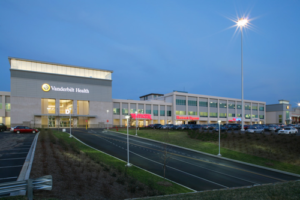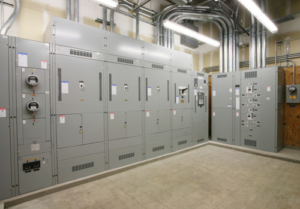Facing decreasing reimbursements and increasing costs, health systems are scrambling to find competitive advantages through improved services provided at a lower cost. Concurrently, medical advancements have reduced trauma and recovery for many procedures and have shifted services once firmly considered as inpatient procedures to the outpatient environment. As a result, healthcare organizations have been shifting hospital-based services to less costly locations for quite some time, and this movement is only expected to continue as long as health systems deal with decreasing margins.
Most organizations are becoming more aggressive in their approach to moving or adding services off campus rather than keeping them on one centralized campus to make it more convenient for patients and to better manage systems costs. While new construction continues to be the default facility solution, adaptive reuse—the process of retrofitting existing buildings for new uses—offers great potential for addressing the needs of healthcare systems.
Repurposing space is an increasingly popular facility strategy for hospital systems expanding or shifting services away from their hospitals because it often requires less capital, and repurposed space can be made operational more quickly than new construction. Most often, the inventory of existing buildings available for adaptive reuse were built for retail use, though office and industrial buildings are also frequently available. Large numbers of buildings, conveniently located, now stand abandoned or underutilized. These spaces often have many of the characteristics that healthcare organizations desire, including good visibility, abundant parking and large, open floor plates.
Adapting these buildings for healthcare use can often save both time and money, with the collateral benefit of reinvigorating the community and bringing care closer to the community. However, with these advantages come design challenges associated with renovating existing buildings into spaces that meet today’s healthcare codes and effectively support clinical practices. The following are some core concepts, questions and best practices that need to be considered when evaluating an existing building for healthcare use.
How Does it Fit within your Strategy?
One of the benefits of adaptive reuse is the potential to capture greater market share by expanding a system’s footprint. However, facilities strategy should support the health system’s broader business strategy. While time and money may be saved by leveraging an existing building, it doesn’t necessarily mean it is the best choice. Above all else, the location and long-term growth potential of the building needs to be considered through the lens of the system’s strategic plan.

The Site: Location, Location, Location!
Visibility, accessibility and parking
Bringing healthcare closer to the consumer is generally considered more convenient and may improve the customer experience. It is important to remember that the site should have good visibility from the street, with easy street access and ample parking. More accessible parking may also be required due to the change to healthcare use.
Site circulation and drop-off
The patient experience begins well before a patient arrives at check-in, and it is essential that site circulation is both simple and intuitive. It’s also important to consider that patients, unlike shoppers, often require covered drop-off zones once they reach the front door, which are not typically provided in a retail or office center. If it is difficult to find and reach the front door, patients may have a less positive experience.
Staying in the zone
One of the challenges in implementing adaptive reuse for healthcare purposes is meeting regulatory constraints, including zoning. Pay careful attention to current zoning, which may limit or even restrict healthcare uses or require variances. This could result in additional costs that may not make a space feasible.
Who are the people in your neighborhood?
Consideration should be given to the site’s immediate neighbors. Some businesses, such as daycare centers or schools, may seem innocuous enough but could ultimately become a disruption at certain times of the day.
The Building: Don’t Force It
Adherence to codes
Additions or alterations to any building must comply with the requirements of the code for new construction. Therefore, bringing an existing structure up to code for use as a healthcare facility can consume a sizable portion of the budget. In a worst-case scenario, it can render a project financially impractical.
Height constraints
 Low floor-to-floor and floor-to-deck heights can pose a considerable challenge, as the 10- or 11-foot ceilings common to strip-mall retail centers and commercial office buildings often don’t work for healthcare facilities. On the other hand, high, single-story spaces found in large retail establishments or “superstores” can present difficulties when constructing interior partitions that meet current healthcare standards for acoustical privacy.
Low floor-to-floor and floor-to-deck heights can pose a considerable challenge, as the 10- or 11-foot ceilings common to strip-mall retail centers and commercial office buildings often don’t work for healthcare facilities. On the other hand, high, single-story spaces found in large retail establishments or “superstores” can present difficulties when constructing interior partitions that meet current healthcare standards for acoustical privacy.
Structural capacity
When changing a building’s use, a structural analysis of the strength of the existing building, including factors such as seismic loading and vibration, must be completed. In adaptive reuse for healthcare, the findings may reveal that the existing structural components—once suitable for a retail or office building—are not adequate or appropriate. For example, bar joist structures extremely common in retail structures may be too “bouncy” for healthcare purposes.
Judging by the cover
The building envelope should receive a complete assessment to determine if the structure is watertight, well-insulated and devoid of mold or mildew.
Making the right impression
For all the site advantages that come with buildings previously used for retail, a lack of visual appeal can present a challenge. Therefore, it is important to ask: Does the existing building design convey the impression the health system desires or will façade changes be required? If the latter is the case, this could elevate the cost to a point where reuse becomes prohibitive.
Vertical circulation
When incorporating medical functions into multifloor buildings originally designed as retail space, elevators are an important consideration as they may require upgrades to support patient volume for a healthcare facility. Elevator cabs for retail buildings often lack ample room for stretchers and other medical equipment and are seldom located conveniently for clinical use.
Fire ratings/partition construction
It is critical that required wall fire ratings are identified early. High floor-to-floor heights will often result in more expensive interior partitions, especially those requiring a fire rating.
HVAC
Mechanical systems in healthcare facilities are far more complex than systems intended for retail spaces. For example, retail HVAC systems are designed for larger, more open spaces that are often not zoned particularly well. Healthcare uses will require new systems or strategies for zoning and controls and will increase airflow and cooling.
Restrooms
Healthcare facilities have significantly greater requirements than retail establishments when it comes to providing restroom facilities. With separate restrooms needed for the public, staff and patients, even small facilities have three to four times the number of fixtures seen in a retail space of the same size. These additional fixtures may require new water and sanitary services.
Electrical system requirements
 The high density of use and equipment loads in healthcare facilities increase the requirements on the electrical system far beyond what a retail system affords. Emergency power systems, if available, will almost certainly not be adequate for new clinical requirements.
The high density of use and equipment loads in healthcare facilities increase the requirements on the electrical system far beyond what a retail system affords. Emergency power systems, if available, will almost certainly not be adequate for new clinical requirements.
Adapting to change
As the healthcare landscape is ever-changing, it is important to consider how the facility will grow and change over time. If the building is unable to adapt to change, it will certainly face abandonment once more.
Yielding the Benefits
Despite the numerous challenges commonly seen in adaptive reuse projects, with careful selection of the right property, a healthcare system may significantly reduce construction time, bringing services to market faster, and saving 20-30 percent of the cost of construction. And as hospital systems become more directly involved in the overall health of the populations they serve, the added benefit of reviving these abandoned, or poorly utilized buildings is that it can help support communities by meeting them where they live, yielding considerable social, environmental and economic benefits.
Photos courtesy of Gresham Smith.





